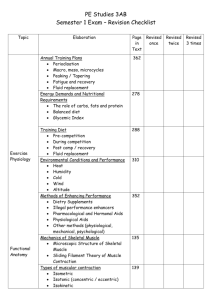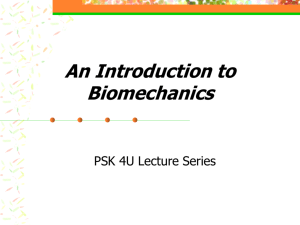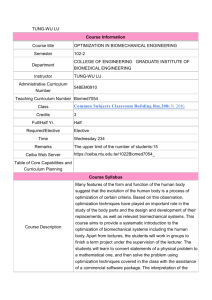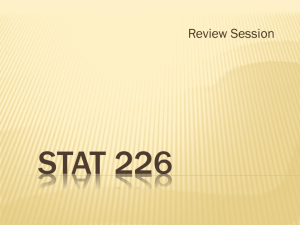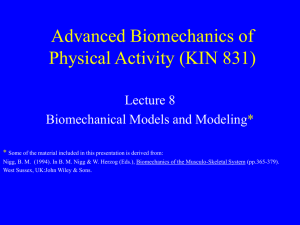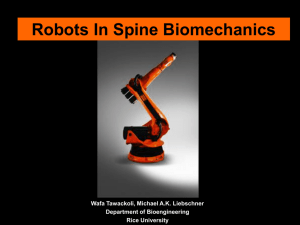File - Yr 11 BIOMECHANICS
advertisement
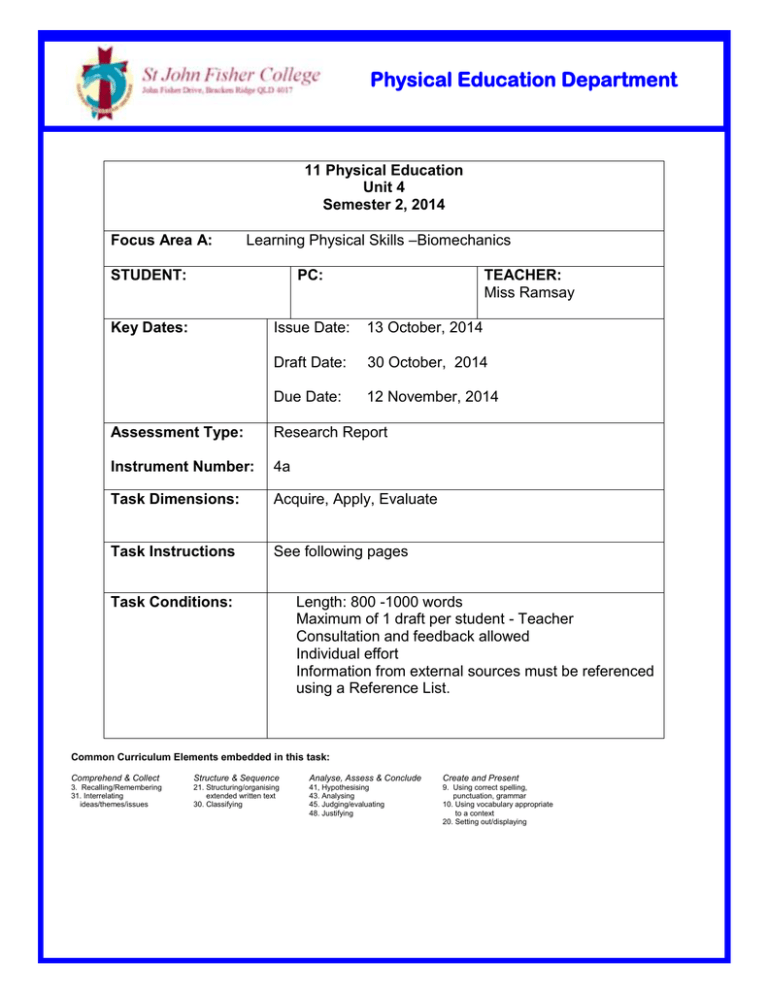
Physical Education Department 11 Physical Education Unit 4 Semester 2, 2014 Focus Area A: Learning Physical Skills –Biomechanics STUDENT: PC: TEACHER: Miss Ramsay Key Dates: Issue Date: 13 October, 2014 Draft Date: 30 October, 2014 Due Date: 12 November, 2014 Assessment Type: Research Report Instrument Number: 4a Task Dimensions: Acquire, Apply, Evaluate Task Instructions See following pages Task Conditions: Length: 800 -1000 words Maximum of 1 draft per student - Teacher Consultation and feedback allowed Individual effort Information from external sources must be referenced using a Reference List. Common Curriculum Elements embedded in this task: Comprehend & Collect Structure & Sequence Analyse, Assess & Conclude Create and Present 3. Recalling/Remembering 31. Interrelating ideas/themes/issues 21. Structuring/organising extended written text 30. Classifying 41, Hypothesising 43. Analysing 45. Judging/evaluating 48. Justifying 9. Using correct spelling, punctuation, grammar 10. Using vocabulary appropriate to a context 20. Setting out/displaying St John Fisher College – Year 11 Physical Education AUTHENTICITY STATEMENT: I declare that the work submitted is my own and no part is written or produced for me by any other person. The plan and draft/s that I have submitted clearly reveal the development of my response. I have acknowledged in the task any other person/s that has provided assistance. Any materials I have used in developing my response have been acknowledged using the school referencing system. Student Signature: ____________________ Date: __________ RESULTS: Dimension Standard Awarded Knowledge Processes Evaluative Processes Research and Communication Topic: Focus Area A Page 2 of 5 St John Fisher College – Year 11 Physical Education Task Focus: During this unit you will be learning various lifesaving techniques and rescues which will be performed in still water. An efficient freestyle technique is both streamline and powerful. Proficiency in the freestyle swimming stroke is necessary in lifesaving to reach a struggling swimmer as quickly as possible. Task: To complete a research report (800 – 1000 words). Conduct a biomechanical analysis of your performance in freestyle to improve your technique. This will allow for improvement in performance for the completion of a timed tow. TASK GUIDELINES: 1. Videotape yourself executing a freestyle swim. 2. Using the video as feedback and other resources, analyse your performance to identify: any technical problems you experience and what you do well in the execution of the skill. 3. Support your biomechanical analysis justifying your selection. 4. After two weeks of training, videotape yourself executing the skill again. 5. Evaluate the second performance of the skill in comparison to the first, identifying areas of improvement within the execution of the skill and evaluate how this affects your overall performance of the skill. 6. COMPLETE THE WRITTEN REPORT Cover page. Contents. (a) Introduction – general performance in lifesaving more specifically freestyle. (b) Analyse the skill in terms of elements of technique. (c) Evaluate your initial execution of the skill using biomechanical terminology and principles (i) Compare and contrast your initial performance of the skill with the ideal performance model. (ii) Identify and comment on technical problems (iii) Identify the things you do well (ie: your level of skill acquisition) (d) Evaluate your second execution of the skill (i) Compare and contrast with the initial performance (ii) Discuss improvement in technical problems (e) Conclusion - Biomechanically evaluate how this affects your overall performance. Bibliography N.B. Throughout this report you are being assessed on the range of relevant biomechanical principles you can identify, how you apply these to explain your freestyle performance on both occasions, and evaluate how they affect the time taken for you to complete your timed tow. Topic: Focus Area A Page 3 of 5 ST JOHN FISHER COLLEGE Year 11 Physical Education Research Report LEARNING PHYSICAL SKILLS Biomechanics and Lifesaving 4a Assessment Task DIMENSION A ACQUIRING The student work has the following characteristics: In-depth comprehension of a wide range of terminologies, principles and concepts relevant to the biomechanical principles specific to the performance of freestyle. Sustained and accurate use of appropriate textual features. B APPLYING D E The student work has the following characteristics: The student work has the following characteristics: The student work has the following characteristics: The student work has the following characteristics: Comprehension of a range of terminologies, principles & concepts relevant to the biomechanical principles specific to the performance of freestyle. Comprehension of fundamental terminologies, principles and facts relevant to the biomechanical principles specific to the performance of freestyle. Recognition of simple terminologies, principles or facts relevant to the biomechanical principles specific to the performance of freestyle. Recognition of some information associated with the biomechanical principles specific to the performance of freestyle. Accurate use of appropriate textual features DIMENSION A STANDARDS C B Use of appropriate textual features. STANDARD C Use of textual features. D Use of texts. E The student work has the following characteristics: The student work has the following characteristics: The student work has the following characteristics: The student work has the following characteristics: The student work has the following characteristics: Insightful, independent and appropriate analysis and application of information relating to the differences in own initial performance of the freestyle swim and the ideal performance as well as improvements made using biomechanical principles. Independent and appropriate analysis and application of information relating to the differences in own initial performance of the freestyle swim and the ideal performance as well as improvements made using biomechanical principles. Appropriate analysis and application of information relating to the differences in own initial performance of the freestyle swim and the ideal performance as well as improvements made using biomechanical principles. Comparison and categorisation of information relating to the differences in own initial performance of the freestyle swim and the ideal performance as well as improvements made using biomechanical principles. Comparison or categorisation of information with assistance. Purposeful and effective selection, sequencing and organisation of relevant and substantial subject matter. Purposeful selection, sequencing and organisation of relevant and substantial subject matter. Suitable selection, sequencing and organisation of relevant subject matter. Selection and sequencing of subject matter. Selection of basic subject matter. DIMENSION EVALUATING A Overall Results Comments: B STANDARDS C D E The student work has the following characteristics: The student work has the following characteristics: The student work has the following characteristics: The student work has the following characteristics: The student work has the following characteristics: Discerning, convincingly justified and independent evaluations, solutions and recommendations concerning the application of biomechanical changes to own performance. Justified and independent evaluations, solutions and recommendations concerning the application of biomechanical changes to own performance. Defended evaluations and solutions concerning the application of biomechanical changes to own performance. Superficial evaluations or solutions concerning the application of biomechanical changes to own performance. Directed responses to problems concerning the application of biomechanical changes to own performance. Discerning and effective choice of communication strategies to enhance meaning and impact. Effective choice of communication strategies that enhance meaning and impact. Effective choice of communicative strategies that convey meaning. Communication strategies that convey meaning. Communication of some meaning. Acquire Apply Evaluate
